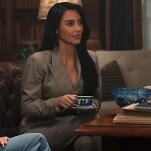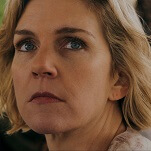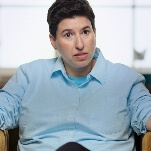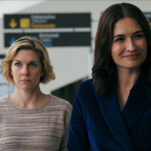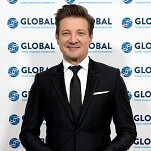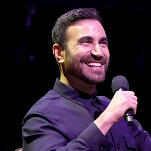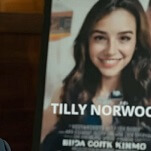From Selena to Undone, Constance Marie has been the matriarch of many an American Family
Image: Graphic: Libby McGuire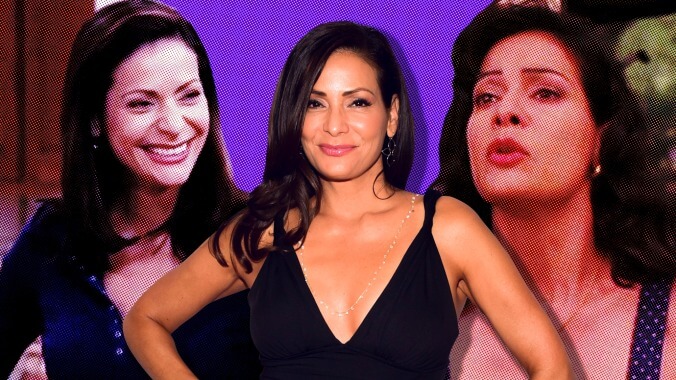

The actor: Constance Marie couldn’t have anticipated it when she first made the move from dancing to acting, but she helped raise a generation of American film and TV fans through her many memorable depictions of motherhood. That’s just one of the many through-lines in Marie’s 30-year career; the George Lopez and Switched At Birth star has also shown a keen interest in projects that offer social commentary. Her decades-long collaboration with Gregory Nava has yielded several groundbreaking moments for the actor, the director, and Latinx people in general, but as part of Amazon’s Undone, Marie continues to seek out new boundaries to cross.
Constance Marie: That was my very first role. I was a dancer, and it was my first acting opportunity. For me, that role was super important because in the movie, the character was white. And they were open to seeing a Latin person in that role. Back then, it was very difficult for Latinos to even play their own roles, even if it was written for a Latin character. This was an event where they were actually changing the role to make it Latin, and I was just very proud to be able to change it. To not only have this be my first acting role, but have it be a little bit groundbreaking. Especially when you consider that the show is set in 1963. It added to the theme of the show, which was you had people who were the patrons—these affluent, sort of elite people—and then the people who worked there. Because it was basically a Downton Abbey. It was the workers and their storylines, and then the more elite, more affluent people’s storylines. So it was very interesting.
CM: It was interesting, because Santa Barbara was the first English-speaking soap opera to have such a focus on Latino characters. There was a Latino side and then the white, more aristocracy side. I didn’t even know Santa Barbara up until that point, until the audition. Up until that point, I actually hadn’t had any formal acting lessons. So it was an acting lesson in itself, because with Dirty Dancing, I was a dancer who could act, you know? I could play a dancer. It was in my wheelhouse because I started as a dancer. But [Santa Barbara] was completely out of my wheelhouse. I played a police officer and a bartender. You know how soap operas are: Your one character will go through so many career changes. That was my second acting job, and you do eight episodes per week.
I failed drama in high school because I was too shy to speak in front of people, and Santa Barbara was basically my acting school. I was opposite a great actor, A. Martinez, and he was a wonderful example of how to knock out and learn an episode of television every single day. Needless to say, there was much stress and many tears at the very beginning of that show, but that was a great education.
The A.V. Club: There is a recurring theme across the roles you’ve chosen—there’s usually an element of class struggle, of social inequality. And in places that you wouldn’t expect to find it, like Santa Barbara. It’s something that goes far back in your career.
CM: I have been very blessed that the roles that I have done, I have had some firsts in some of the things that I’ve done. Especially a show like Undone. I mean, that’s something that’s never been done on TV on that scale. I come from a time when Latinos couldn’t even play their own roles unless they were the traditional maid roles—and even then they were outsourced to different ethnicities. On many levels there is the class system, which exists anywhere. There were all the clichéd roles, which I very much tried to stay away from. Not that I looked down upon them, but that’s not what resonated with me. I can trace my family’s roots in the United States back to 1850. So technically, half my family never crossed any border. We were just always here. So for myself, those were the roles that resonated with me, and I was very excited to be able to attain them.
AVC: Gregory Nava’s My Family was basically my introduction to your work, and it definitely explores the different types of journeys and history that Latinos, specifically Mexicans and Mexican Americans, have had in this country.
CM: Other than La Bamba, there had never been a feature film where all the Latino roles were played by Latinos. At that same time, The House Of The Spirits came out, and it was Jeremy Irons, Meryl Streep and Winona Ryder in the main cast, and then you had Maria Conchita Alonso and Antonio Banderas as this supporting character. Then Zorro came out, and you know, it’s Anthony Hopkins as the old Zorro, and the villains, they all had English accents. [Laughs.] And that was like, wait a minute? But that’s why I think it took Gregory Nava five years to get my My Family—Mi Familia—made because nobody wanted to do it with actual Latinos in the Latino roles. They wanted to change them to Italian or Irish, or they wanted to cast non-Latinos. Gregory Nava, who went to such lengths to make El Norte, was not going to let that happen.
AVC: It really made a difference to have Latinos in these roles. The Perez Family—which was about Cuban refugees but had a mostly white cast—came out around the same time and did not do very well. But the other thing about the cast for My Family is that so many of you went on to work together in other projects: Edward James Olmos, Lupe Ontiveros, and even Jennifer Lopez.
CM: Yes. It’s funny, in Mi Familia, or My Family, [Jennifer Lopez] plays my mother, and then I play her mother in Selena.
CM: I tested along with Jennifer Lopez to play Selena because I had worked with Gregory Nava on Mi Familia. He was very sweet. He brought me into a meeting and told me that I didn’t get it. But then immediately said, “Would you be interested in playing the mother?” And that was something that I had’t even thought of because the mother was so much older. But he said, “Have a read and think about it.” So I read it, and I thought about it. I’d already been playing mothers for so long, way before I was a mother in real life. I was only three years older than Jennifer, but it just kind of clicked. I thought no matter how old your child is, they’re still your baby. No matter how old you are, your mom always babies you. And it was the same makeup team for My Family that did my hair and makeup for Selena. Actually, Selena’s mother—I was her favorite.
AVC: When I talked to Kate Purdy for Undone, I told her that for me and a lot of Latinos, you’re just this iconic mom. You’re our Florence Henderson. I was like, “She’s our Mrs. Brady!”
CM: [Laughs.] You know what? I never thought about that, but that is a great analogy. It’s true!
AVC: Do people ask you to teach them to do “the washing machine?”
CM: Every day. It’s like this iconic thing, and it’s so funny. The story behind it is the little girl who played the young Selena, she had this routine down. She was very good at it, and the choreographer and I liked her style, so basically I had to learn her style. And the choreographer started giving names to each dance, so that way we could just call it out, and Becky Lee Meza, she could just do it on cue. And so we named it “the washing machine.” It was that little move that she could do. I mean, of course I did my own spin on it, but that was her move, and we called it “the washing machine.” So I could say it in the line to get her to do it. That’s how it became some of the dialogue.
AVC: There are so many moments from the movie—a personal favorite is “Me siento muy excited!”—that people quote. Another one that comes up so often for so many reasons is the father’s line: “We’ve got to be more Mexican than the Mexicans and more American than the Americans, both at the same time!”
CM: Yes, yes. I didn’t realize how true that was until I heard Gregory Nava’s words. But it’s so true. It might sound like a horrible way of saying it, but you bear the burden of both cultures. And you are constantly being taken to task. For me, on one side of my family, I’m fifth-generation American. And I’m third-generation Angeleno, so I didn’t grow up speaking Spanish. Because my mom worked two jobs, I had a babysitter who was from Nicaragua and spoke no English. Basically, it was survival. I had to learn Spanish because she didn’t speak any English. That’s how I learned, and that’s why my accent is okay. But then when I started doing all these projects, which were very Latino-themed, and I had to do interviews for CNN en Español, and I’m like, “Oh, my god.” [Laughs.] In My Family, I played a political activist, and the interviewers were very interested in the immigration story. So I went back to school—I went to Berlitz, and everything from when I was a child came flying back at me. Of course I failed Spanish in my junior year of high school because back then I spoke Spanish like a 5-year-old. But once I had my daughter and the nanny came and said, “I’m going to practice my English,” I said, “No, thank you! I want you to speak to me in Spanish all the time. I want you to speak to my daughter only in Spanish,” and so she has the same gift that I got of the language.
Back to bearing the burden: For auditions, people would hand me scenes in English and expect me to just automatically translate it into Spanish. That was really difficult, because you’re expected to just turn it on at a moment’s notice regardless of your actual background.
CM: It was so great, working with that cast because they were all legends: Héctor Elizondo, Raquel Welch. I was just so proud to be able to do it, and my role was the surprise role. It was sort of a, what would they call it? A May-December romance with Héctor Elizondo. That one was great because I learned so much from everybody, but also because it was based on Eat Drink Man Woman—you know, the Ang Lee movie? Again, I originally read for the lead role and I ended up getting the smaller role, which I was totally fine with. But to be the surprise ending was wonderful. And for it to be sort of a dramatic family thing, but also a comedy… I feel really blessed to be able to do comedy and drama for the last 30 years. That one was a little extra dramatic for me because I sliced open my hand, and I severed the muscles and tendons and nerves in my right hand, which was no fun. That role was a little… I just had to get through that one.
CM: Gregory Nava loves the iconic figure of the single Latina. He loves showing how formidable that character is, and the many, many accomplishments and things women like that have done. So he saw this as an extension of my character in Mi Familia, who became a political activist. It was originally a pilot for CBS, who passed. Then PBS came in, they wanted to make it happen, and they told me I was on a very short list. [Laughs.] I said to Gregory Nava, “You know what? I’m on the short list, so I very much want to do it.” And he said, “Constance, you are the list. What do you mean?”
I was very excited to bring this story to television, because I grew up with TV, you know? I didn’t have money to go to the movies and Broadway and all that sort of stuff. But to think, bringing it to television was super iconic for myself, especially because I thought there had been ethnic cleansing of the TV airwaves up until that time. I very much believed in it, and it was truly wonderful. For me, the most amazing part of it was that because it was PBS, and because it was the format that it was, I was able to do George Lopez at the same time. I actually did George Lopez, the sitcom, and American Family at the same time for one year. They overlapped.
CM: I’m super proud of this show. George Lopez was the first Latino show in television history that made it past 13 episodes. We got to 120.
AVC: Again, it’s interesting to think that you worked on these two shows, which marked some significant milestones for Latino creatives, at the same time. And they’re two very different formats. American Family allowed you to address some things you probably couldn’t get into in a sitcom.
CM: Right.
AVC: Did you feel the burden of representation in working on two shows, especially ones that are historic for different reasons? Did you feel like there was greater pressure on you in juggling that?
CM: Honestly? I feel that in my life everyday especially in this political climate, when the reputation or the slander for an ethnicity happens constantly. I’m used to living here in America and being the only Latino person in the room. So I am often literally representing us Latinos. I was used to that while working on those shows, but I had amazing writers, amazing directors, and amazing support from networks, so yes, there was pressure. But it was more important to just do quality work, not so much just as a Latin actress, but as an actress. There’s pressure just in that. It’s so funny, my mom always said to me, “Life is pressure. You’ve just got to deal with it.”
AVC: A couple of years ago, George Lopez said he was interested in bringing the show back. If they revived it, would you be up for returning?`
CM: In a heartbeat. I think that show is very necessary right now. It would be a wonderful reflection. We need comedy. The only reason that show went away was because, at the time, everybody was saying that family situation-comedies were going the way of the dinosaur, and nobody was interested in them anymore. Single-camera comedies like Scrubs were what people were interested in making. A lot of the situational-comedies, the family comedies, went away, and it took a while for them to come back. I would totally do it, because I think we need it. We need the representation where Latinos are just regular people: regular people with family problems, and they just happen to be Latino. And that show holds up.
CM: Switched At Birth, there was another case of the haves and the have-nots.
AVC: Is that something you seek out in your work, that kind of social commentary?
CM: Oh yeah. If I don’t believe in the role or identify with the role, I think I would be absolutely horrible in the role. Like, just bad acting. I don’t think I would be able to pull it off. But if it’s something that I love and that I believe in, I’m all over it. And I’m really blessed because I happen to have a career with all these projects that have so much integrity and are pioneering—I really, really love them. Switched At Birth was one of the first shows to center around deaf characters. It was the first show to have multiple deaf actors in the cast. Before that, Marlee Matlin [who played Melody Bledsoe] had been on Reasonable Doubts, where she was the deaf person on a hearing show. But our show was like half and half [hearing people and deaf people], and that had never been done before.
To have a show like Undone come after American Family, George Lopez, and Switched At Birth is really just magic. The show is just so dramatic and touching and funny. There are so many Latino characters, but they get to just be a family. It’s rotoscoped, which is still so rare on TV. We also have deaf characters and actors.
AVC: There’s a moment where your character in Undone, Camila, reminds her husband, Jacob [Bob Odenkirk], that the reason she didn’t speak Spanish to their daughters was because he said he’d feel excluded. That part of the story homed in on something that I think gets glossed over in a lot of stories about interracial couples, and that’s that there are parts of each other’s cultures that you won’t get—certainly not reflexively.
CM: Yes, and the show looks at that in different ways. Jacob tells Camila [as they debate whether their daughter, Alma, should get a cochlear implant] she should just learn sign language, and she says, “Oh, if it’s so easy, then why didn’t you learn Spanish?” The sad part is that 85% of parents of deaf children do not learn sign language. But I’ve been on both sides of this—the sign language issue and the Spanish issue, because I didn’t grow up speaking Spanish. People struggle with learning a new language, whether it’s Spanish or sign language, but the statistics for sign language are that 85 percent of the parents do not learn. As far as Spanish, I know parents who only speak Spanish to their kids because they want their kids to not forget it, and then the kids still end up only speaking English. It’s not easy for anyone.
AVC: These discussions and cultures come up very organically on the show, in part because of where it’s set: San Antonio. To paraphrase something Chris Rock said about Los Angeles, you’d have to try really hard to exclude Mexican Americans from a narrative set in San Antonio.
CM: Exactly. But take Friends—it was set in New York, yet everyone was white. I always thought, what part of New York is this? Because if you just stand on the corner, you hear so many different languages, you see so many different cultures. I love the show, but that was one thing I never liked. There was one African American character on it, played by Aisha Tyler. She was the only African American on that! And my friend Carlos Gómez played a Latino on it, when I think he was romancing Courteney Cox. I thought, where in New York is this? What coffee shop is this?
AVC: That’s the thing about Undone, that it is a surreal show that, for me, presents one of the most realistic portrayals of Latinos that I’ve seen on TV, but it does that while being so smart and grounded in its sense of place. There are moments where it takes into account something you mentioned earlier, that there are Mexicans who never crossed the border—the border crossed them.
CM: Exactly. If you think about Gregory Nava’s Mi Familia, there’s one character, El Californio, who was the man who had just always been here in California. Later, he’s deemed an immigrant, but the people who came after him and his family were the immigrants.
AVC: Undone feels very much like where you started from in terms of thoughtfulness and honesty, but it’s all being told in a very modern way—in the sense that the mix of animation styles and rotoscoping, along with the oil painting backgrounds, couldn’t have been done before. It’s, as you’ve said, another pioneering moment. There’s a certain poetry in that, all these years later.
CM: Poetry is a good word, but it feels like home. These are the kind of projects that I always want to work on, and the fact that my daughter, my real-life daughter, gets to be part of this show, is just so beautiful and touching. With Undone, we knew the script, we knew the writing, and we still had no idea what it was going to look like. We literally stood in a little office building with big, white pieces of cardboard behind us with black tape and a prop in our hand, and that was it. There was tape on the floor as to where the doors would be and where the furniture would be. It was like we were in our backyard using our imaginations. I think that’s what we’ve had to do with so many of these [“firsts”] is use our imagination.
GET A.V.CLUB RIGHT IN YOUR INBOX
Pop culture obsessives writing for the pop culture obsessed.

